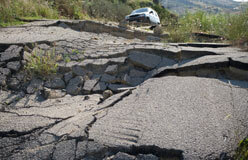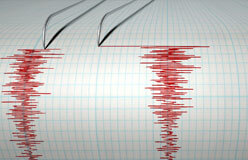Earthquakes have always happened on this planet. They’ve been shaking the Earth for all 4.6 billion years of its existence.
Although today’s scientists have learned a lot about them, earthquakes are still difficult to predict and impossible to control. Today, most scientists think that earthquakes happen when the rocky plates covering the Earth press so hard against each other that the rock breaks. These plates are moving all the time, but usually the rock is bending very slowly, so there’s no sudden, violent movement. Yet finally, the rock can bend no further. It breaks and snaps back to its original shape, like a rubber band that has been stretched and broken. Then an earthquake happens. This explanation is called the elastic rebound theory.
When the rock breaks, a huge amount of energy is released—causing waves, known as seismic waves, to travel through the Earth and over its surface. The place where the energy is released is the center, or focus, of the quake. The waves look like water waves, rippling away from the focus.








